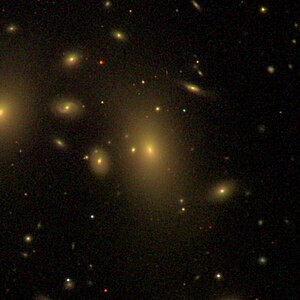NGC 7499
| Galaxy NGC 7499 |
|
|---|---|

|
|
| SDSS recording | |
| AladinLite | |
| Constellation | fishes |
|
Position equinox : J2000.0 , epoch : J2000.0 |
|
| Right ascension | 23 h 10 m 22.4 s |
| declination | + 07 ° 34 ′ 50 ″ |
| Appearance | |
| Morphological type | SA (s) 0 ^ 0 ^: |
| Brightness (visual) | 13 likes |
| Brightness (B-band) | 14 likes |
| Angular expansion | 1.2 '× 0.7' |
| Position angle | 10 ° |
| Surface brightness | 12.7 mag / arcmin² |
| Physical data | |
| Redshift | 0.039150 ± 0.000093 |
| Radial velocity | 11737 ± 28 km / s |
|
Stroke distance v rad / H 0 |
(531 ± 37) · 10 6 Lj (162.9 ± 11.4) Mpc |
| history | |
| discovery | Albert Marth |
| Discovery date | September 2, 1864 |
| Catalog names | |
| NGC 7499 • UGC 12397 • PGC 70608 • CGCG 406-007 • MCG + 01-59-005 • 2MASX J23102237 + 0734501 • GALEX ASC J231022.36 + 073450.9 | |
NGC 7499 is a lenticular galaxy with extensive star formation regions of the Hubble type S0 in the constellation Pisces on the ecliptic . It is estimated to be 531 million light years from the Milky Way and about 185,000 light years in diameter.
In the same area of the sky are u. a. the galaxies NGC 7501 and NGC 7503 .
The Type Ia supernova SN 1986M was observed here.
The object was discovered by Albert Marth on September 2, 1864 .
